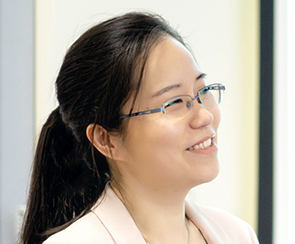We know artificial intelligence is a powerful tool, but the question now is: How do we get AI into the hands of professionals who can do the most good with it? This is where human-AI interaction scholars like Qian Yang play a critical role in designing and integrating artificial intelligence solutions that serve human ends.
A newly hired assistant professor in Cornell’s Department of Information Science, Yang is a rare blend of HCI expert, machine learning engineer, and user experience designer. This unique convergence of technical skill and design knowledge offers Yang a holistic view of AI’s potential across industries: she understands both the technical side of the algorithms that drive artificial intelligence and the design challenges that come with integrating AI solutions into everyday work and lives in ways that are seamless.
Yang Qian crop.jpg

“I work in the middle in trying to bridge the two sides of human computer interaction – the scholars who work on the human complexity side, and those who work to advance the technology,” she said. “I build upon the research that machine learning scholars have done and bring the technologies they built to the messy real world. I also build upon human-centered research – for example, research on peoples’ perception of AI and interaction with it – and operationalize these insights, to make AI work for everyday users.”
Along with developing AI applications in areas like natural language generation and autonomous cars, Yang also works to bring the power of AI to doctors making high-consequence decisions. In research that earned her a Best Paper Award at CHI 2019, Yang collaborated with cardiologists to develop a machine learning system – known as a decision support tool – that crunches electronic health records and predicts the likelihood of a patient having a successful heart implant surgery, a notoriously risky procedure with low survival rates. Elsewhere, she continues work on a medical imaging AI assistant that can assist doctors in spotting cancer in biopsy images.
Developing an AI tool is one challenge; getting medical professionals to use it and use it appropriately is another. This is where HCI research is critical, Yang said. To inform the development of the cardiology AI tool, Yang’s team set out to understand the real-world human contexts that the tool would operate in. Some of the questions that guided the team’s design: How did cardiology team members assess and manage implant risks of patients? How did they communicate with each other about the uncertainties in their risk assessments? How did they collaborate as a group to make these implant decisions?
“These human-centric insights informed how we design and build our AI systems for similar high-consequence contexts,” Yang said. “While AI does introduce many new challenges – or new complexities to these old challenges –many old lessons and methods of HCI remain hugely valuable. And I see this body of knowledge as a strength of mine in working on AI.”
Yang arrives to Cornell from Carnegie Mellon's School of Computer Science, where she completed her PhD in human-computer Interaction. She holds master's degrees in HCI from Carnegie Mellon and in Design and Bachelor of Engineering in Industrial Design from Shanghai Jiaotong University. Prior to her studies at Carnegie Mellon, she worked in design consultancy and in the tech industry. This fall, she’ll teach INFO 3450, “HCI Design”.
“I’m excited about Info Sci’s interdisciplinary culture, which I think is awesome,” Yang said. “My work is very much in an in-between space, so Info Sci’s breadth of researchers, its appetite for interdisciplinary work, and its collaborative nature are all so exciting.”
Louis DiPietro is the communications coordinator for Information Science.



